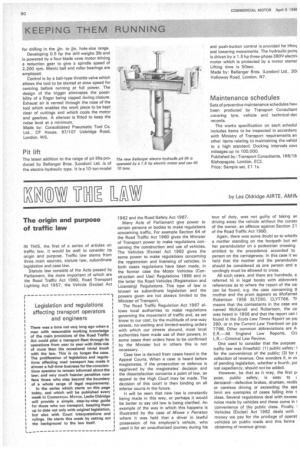HaNg Llftfl 11,1M by Les Oldridge AIRTE, AMIN
Page 62

If you've noticed an error in this article please click here to report it so we can fix it.
The origin and purpose of traffic law
IN THIS, the first of a series of articles on traffic law, it would be well to consider its origin and purpose. Traffic law stems from three main sources, statute law, subordinate legislation and case law.
Statute law consists of the Acts passed by Parliament, the rnore important of which are the Road Traffic Act 1960, Road Transport Lighting Act 1957, the Vehicle (Excise) Act 1962 and the Road Safety Act 1967.
Many Acts of Parliament give power to certain persons or bodies to make regulations concerning traffic. For example Section 64 of the Road Traffic Act 1960 gives the Minister of Transport power to make regulations concerning the construction and use of vehicles. The Vehicles (Excise) Act 1962 gives the same power to make regulations concerning the registration and licensing of vehicles. In both cases regulations have been made, in the former case the Motor Vehicles (Construction and Use) Regulations 1966 and in the latter the Road Vehicles (Registration and Licensing) Regulations. This type of law is known as subordinate legislation and the powers given are not always limited to the Minister of Transport.
The Road Traffic Regulation Act 1967 allows local authorities to make regulations governing the movement of traffic and, as we know to our cost, by the multitude of one-way streets, no-waiting and limited-waiting orders with which our streets abound, most local authorities have made use of their powers. In some cases their orders have to be confirmed by the Minister but in others this is not necessary.
Case law is derived from cases heard in the Appeal Courts. When a case is heard before magistrates, if the prosecution or defence is aggrieved by the magistrates' decision and the dissatisfaction concerns a point of law, an appeal to the High Court may be made, The decision of this court is then binding on all inferior courts in the future.
It will be seen that new law is constantly being made in this way, or perhaps it would be better to say old law is being clarified. An example of the way in which this happens is illustrated by the case of Mowe v Perraton where it was held that a driver in lawful possession of his employer's vehicle, who used it for an unauthorized journey during his tour of duty, was not guilty of taking an driving away the vehicle without the conser of the owner, an offence against Section 21 of the Road Traffic Act 1960.
Again, there was some doubt as to whethi a mother standing on the footpath but wii her perambulator on a pedestrian crossing entitled to the precedence accorded to person on the carriageway. In this case it vi.q held that the mother and the perambulat should be considered as one person and a cordingly must be allowed to cross.
All such cases, and there are hundreds, a referred to in legal books with abbreviatE references as to where the report of the cal can be found, e.g. the case concerning ti mother and the pram appears as McKerreh Robertson 1956 5LT290, CLY7766. TF means that the contestants in the case we named McKerrell and Robertson, the ca was heard in 1956 and that the report can I found in the Scots Law Times Report on pa! 290, or in the Current Law Yearbook an pa! 7766. Other common abbreviations are A ER.—All England Law Reports, Chi L.R.—Criminal Law Review.
One used to consider that the purpose traffic law was threefold : (1) public safety; ( for the convenience of the public: (3) for t collection of revenue. One wonders if, in vu of pending legislation, whether a fourth, poi ical expediency, should not be added.
However, be that as it may, the first pi pose, public safety, is easy to derstand—defective brakes, drunken, recklE or careless driving or exceeding the spe limit are examples of cases falling into t class. Several regulations deal with excess noise made by vehicles and these come in 1 convenience of the public class. Finally, I Vehicles (Excise) Act 1962 deals with • money we pay for the privilege of operat vehicles on public roads and this forms • obtaining of revenue group.




























































































































































